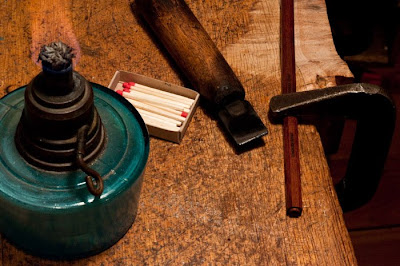
The stamp itself is cut from steel by an artisan engraver and will last a lifetime. However, makers would change stamps for various reasons. Sartory went through a couple before he settled on his well known stamp with the wear on the first letter. Stephane Thomachot and I ordered our stamps together from a little shop in the Marais, rue Pont aux Choux I think. The proprietor sold stamps of all kind but I believe he had our stamps made by another artisan. The stamps were cut by hand with punches and files and were fairly crude under magnification. Not long after that the engraver Boutroué offered stamps made with a special milling machine that were far more precise but I think the hand made stamps have a lot of character.
Stamping is done with a stamp that has been heated over an alcohol lamp. Then a match is burned under it to apply some carbon black to impress into the wood. The stamp should not be hot enough to actually burn the wood but the heat helps it penetrate. The stamp is applied freehand and this is difficult so it is not unusual to see a crooked stamp. Violin bridge stamps had a face in the form of an arc and were rolled onto the bridge. Vuillaume’s bow stamp was also of this type, which explains why his stamps wander. The collector Jean Trible told me the story of acquiring an unstamped gold mounted bow he was certain had been made by Emile August Ouchard. He arranged to visit Ouchard at his home in the country one Sunday hoping that he could return with a stamped bow. Ouchard agreed that he had made the bow but having consumed a lot of wine that day overheated his stamp. The results were barely recognizable but Trible remembered the day with amusement.




No comments:
Post a Comment